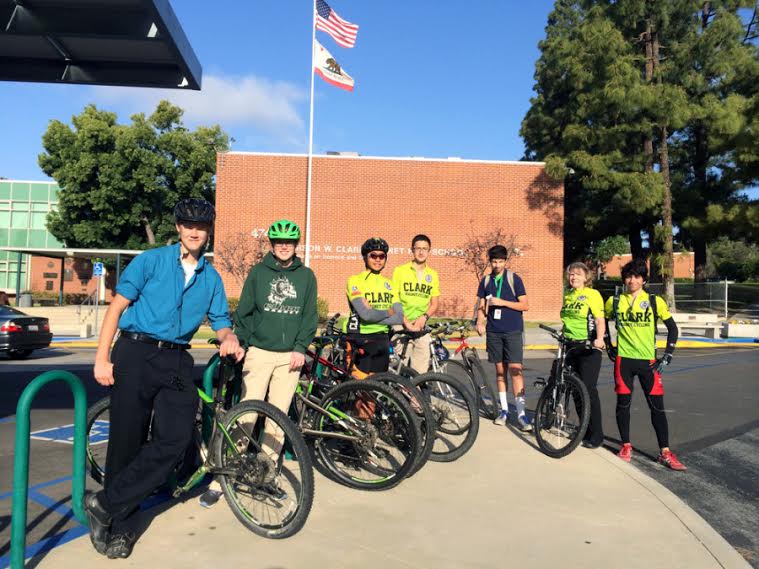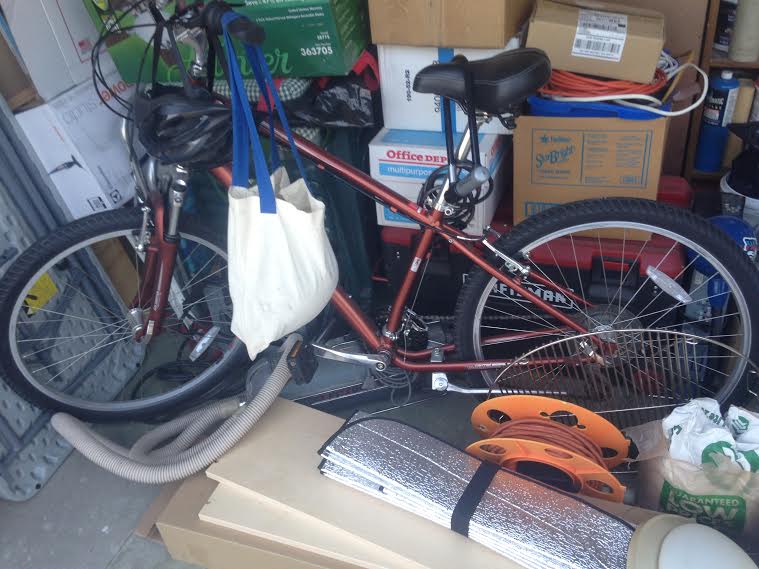Bike Month proves to be a challenge
How I ditched pistons for pedals
May 28, 2015
The halfway point! At this point I was still on the flat parts of the street–little did I know what was coming.
Let’s face it, I’m a very sedentary person. I parked in the teacher’s parking lot for three months straight first semester because the walk from the student parking lot to my AP Spanish class was too far and physically taxing for me; plus, the 30-second walk from from that lot to class was far nicer than the nearly five-minute trek from the student lot.
Nonetheless, the whole “bike-to-work” movement has always been something that’s intrigued me. Why drive when you can bike?
National Bike Month was established in 1956 as a way to promote the use of bicycles as opposed to other less than environmentally-friendly modes of transportation. Not only is bike riding good for the environment, as many people have said, but it’s also good for your own health.
Despite that, statistics from the League of American Bicyclists show that bicycle commuting in California has grown only 29% from 2005 to 2013, with 2013 being at 69%. States such as Pennsylvania and Louisiana both surpass an increase of 100% from 2005 to 2013.
I didn’t understand how that could be — California is a bigger state than the other two states combined — until I tried to commute by bike myself. Being one to avoid anything remotely strenuous, it took me weeks to muster up the courage and motivation and drive to actually wake up early and bike to school, rather than just taking my car. Even my parents thought I was crazy for planning to bike to school, but were nonetheless pleasantly surprised.

Clark Magnet Bike Team’s first Bike to School day in 2014.
Psyching myself up was half the battle, as I’d have to break my habit of late mornings and unexcused tardies that I had grown so accustomed to during my senior year. I’ve rarely woken up earlier than 7:30, so I had to wake up at six on Thursday, May 21 to prepare by having a big breakfast. This was just the start.
I live in Montrose, which is fairly close to Clark — it’s about two and a half miles away. Not bad, I thought. According to Google maps, it should take me a maximum of 21 minutes, apparently, to get from my house to school by bicycle. I concluded that that was fairly reasonable, even though it would take me seven minutes, at most, if I took my car instead. I was considering backing out and sleeping in a little bit longer, but something told me I should give it a shot, since I was highly likely to never use my bicycle to commute anywhere.
So on the morning of my journey, after preparing myself mentally and grabbing a bite to eat, I went west on Foothill Boulevard until I got to New York Avenue where I turned right and walked my bike and myself up to Clark. There was no way you could get me to bike up that hill. Not once did I consider going up there on my bike. I thought that going on Foothill was enough exercise for me for the day. Hopefully I wouldn’t pass out by the time I locked my bike up on the bike racks.
It was scary to be on the street next to cars, but the bike lane that was painted three years ago was nice and clear enough for me not to get too intimidated. In retrospect, I don’t know what I was thinking. I was sweating within ten minutes and regretted wearing a hoodie, even though it was quite cool that morning. I got tired, too. I wanted to call my dad to pick me and my bike up once I got to New York Avenue, but I decided against it. I was going to get to school myself.
The ride took me an hour and a half to get to school because I stopped to get donuts on the way — the breakfast I’d had didn’t suffice and was immediately burned as soon as I had gotten on my bike — and I didn’t realize how long or how hard it would be to walk my bike up the hill. To those who walk up that hill every morning, I salute you.
Carol Pettegrew, the team advisor for Clark Magnet’s Bike Team, said that she wished that she had participated in the “Bike to Work” day on May 14, “None of us did it this year, but we’ve been riding on the street and up in the mountains the whole year.”
Pettegrew was keen to give her perspective about the importance of Bike Month and overall bicycle awareness. “I think everyone should be required to get on a bike at least once, just to get the perspective of the cyclist,” she said. Pettegrew explained that most automobile drivers see the bikers are obstacles, but in reality “sometimes the cyclists will ride into the car lanes, but it could be because there’s glass in their lane or something,” she said.
Bike safety has been a topic of controversy, mostly because drivers feel that the mere presence of these cyclists is a danger to them. To combat the issue of the comfort of drivers and the safety of cyclists, California lawmakers passed a law last year that requires drivers to “give bicyclists three feet as they pass them on the road.”
This is an effort to decrease the number of cyclist-driver accidents, in light of the subtle increase of bikers. This measure is one that is fully warranted, as my hometown of Montrose has seen many bicycle-car collisions, one of them involving an alumni. The crash was between Clark alumnus Dillen Maurer and a driver. “It was a couple of years ago,” Pettegrew said. “He was riding on the street and a car pulled into the street and hit him.” Maurer was wearing a helmet; however he still suffered some injury to his neck. “It didn’t stop him,” Pettegrew said. “He still races at his school, UCSC.”

My beautiful caramel colored bike sitting the garage hidden by my dad’s electrical equipment. I don’t bike too often so it’s kind of just sat there for months on end.
I can attest to the potential for conflict or collision between cyclist and automobile driver, as I’ve raged at many a cyclist before. Pettegrew said that Bike Month as a whole is a great movement to raise awareness for safer cycling. “It’s fun, it’s healthy and everyone should take part in this baby step,” she said.
While I was biking along Foothill, I wondered why people rode their bikes to get around. According to an article titled “Why Bike?” by bicycling expert David Fielder, the top five reasons go as follows: for the body (increased cardiovascular fitness, strength, balance and flexibility, endurance and stamina, and calories burned); for the state of mind — bike riding is a proven stress-reliever; for the community (no negative environmental consequence and one less car on the road); convenience (easier parking and less traffic wait time); and for cost, since it costs nothing to ride a bike, and nothing short of an arm and a leg to drive a car (gas, repairs, metered parking).
After getting to school, I decided to ask Robert Herrin, a junior on the Bike Team, about his experience with biking to school his freshman and sophomore years of high school. I wanted to compare a regular biker’s thoughts to mine. “I live in La Crescenta, so it wasn’t too far, but biking here cut down on the time it took to get to school and to get home after,” Herrin said, as he used to walk to school. “It was nice, I did it for two years but not anymore.” Herrin also said how having a bike delayed his need for a car. “I have a way to get places, so getting my license isn’t so important right now.”
Okay, so maybe biking isn’t that bad. The benefits do seem to outweigh the cons (if there are any, at least). It was a big step for me, to go from driving back and forth every day to using my bike, switching from gas pedal to bike pedal, but it proved to be a positive experience for me. Maybe I’ll even try it again.
